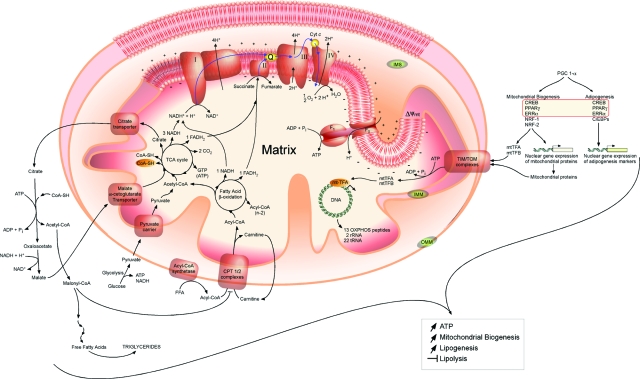Figure 1.
Main mitochondrial functions in adipocytes. Pyruvate derived from glucose by glycolysis in the cytosol is converted, after uptake, into acetyl-CoA in the matrix. Acetyl groups pass out of the mitochondrion as citrate; in the cytosol, acetyl-CoA is released for fatty acid synthesis eventually esterified TGs. Oxaloacetate is reduced to malate, which returns to the mitochondrial matrix and is converted to oxaloacetate, a TCA cycle intermediate. Alternatively, free fatty acids are taken by the carnitine-palmitoyl-transferase-1 (CPT-1) complexes into the mitochondrial matrix and are oxidized to yield acetyl residues in the form of acetyl-CoA in a process called fatty acid β-oxidation. The acetyl groups are oxidized to CO2 via the TCA cycle. Electrons derived from oxido-reduction reactions are finally accepted by O2. The energy is retrieved as an electrochemical proton gradient used as the driving force for ATP synthesis. Besides, the coactivator PGC1-α contributes to both mitochondrial biogenesis in adipocytes and adipogenesis itself by activating specific transcription factors involved in the expression of nuclear genes encoding mitochondrial proteins and/or adipogenic markers. Both mitochondrial proteins and transcription factors such as mitochondrial transcription factors A and B (mtTFA and mtTFB) are imported into mitochondria by translocase outer membrane/translocase inner membrane (TOM/TIM) complexes: mtTFA and mtTFB being specifically involved in mtDNA replication. Increased mitochondrial biogenesis goes along with both an enhance ATP production and lipogenesis, whereas lipolysis is inhibited during adipocyte differentiation. OMM, outer mitochondrial membrane; IMS, intermembrane space; IMM, inner mitochondrial membrane.

